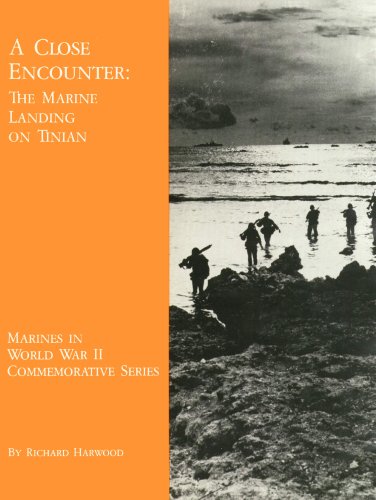
The Project Gutenberg EBook of A Close Encounter: The Marine Landing on Tinian, by Richard Harwood This eBook is for the use of anyone anywhere in the United States and most other parts of the world at no cost and with almost no restrictions whatsoever. You may copy it, give it away or re-use it under the terms of the Project Gutenberg License included with this eBook or online at www.gutenberg.org. If you are not located in the United States, you'll have to check the laws of the country where you are located before using this ebook. Title: A Close Encounter: The Marine Landing on Tinian Author: Richard Harwood Release Date: May 16, 2015 [EBook #48969] Language: English Character set encoding: UTF-8 *** START OF THIS PROJECT GUTENBERG EBOOK A CLOSE ENCOUNTER *** Produced by Brian Coe, Charlie Howard, and the Online Distributed Proofreading Team at http://www.pgdp.net (This file was produced from images generously made available by The Internet Archive/American Libraries.)
Transcriber’s note: Table of Contents added by Transcriber and placed into the Public Domain.
Marines in
World War II
Commemorative Series
By Richard Harwood


by Richard Harwood
Three weeks into the battle for Saipan, there was no doubt about the outcome and V Amphibious Corps (VAC) commanders began turning their attention to the next objective—the island of Tinian, clearly visible three miles off Saipan’s southwest coast. Its garrison of 9,000 Japanese army and navy combatants, many of them veterans of the campaigns in Manchuria, had been bombarded for seven weeks by U.S. air and sea armadas, joined in late June by massed Marine Corps and Army artillery battalions on Saipan’s southern coast. The 2d and 4th Marine Divisions, both still in the thick of the Saipan fight, had been selected for the assault mission.
The crucial question of where they would land, however, was still undecided. There was strong support among the planners for a landing on two narrow sand strips—code named White 1 and White 2—on Tinian’s northwest coast; one was 60 yards wide, the other 160. But Vice Admiral Richmond K. Turner, overall commander of the Marianas Expeditionary Force, was skeptical. He leaned toward Yellow Beach, made up of several wide, sandy strips in front of Tinian Town, the island’s heavily fortified administrative and commercial center.
On 3 July, VAC’s Amphibious Reconnaissance Battalion, commanded by Captain James L. Jones, was put on alert for reconnaissance of these potential landing sites. On 9 July, the day Saipan officially was declared secured, Jones got his operation order from Marine Lieutenant General Holland M. Smith, commander of Expeditionary Troops. His men were to scout out the Tinian beaches and their fortifications and determine their capacity to handle the landing force and keep it supplied. Accompanying naval underwater demolition teams would do the hydrographic work and locate underwater obstacles, natural or man-made.
Captain Jones picked for the job Company A under the command of Captain Merwin H. Silverthorn, Jr., the son of a Marine general and World War I veteran, and Company B, commanded by First Lieutenant Leo B. Shinn. The Navy assigned to the mission Underwater (UDT) Team 5, led by Lieutenant Commander Draper L. Kauffman, and UDT Team 7 under Lieutenant Richard F. Burke. They rehearsed the operation on the night of 9–10 July off the beaches of Saipan’s Magicienne Bay. On the evening of the 10th, the Marine and Navy units boarded the destroyer transports Gilmer and Stringham for the short trip into the channels separating the two islands.
The teams debarked in rubber boats at 2030, paddled to within 500 yards of the beach and swam to their destinations. Fortunately, it was a black night and although the moon rose at 2230, it was largely obscured by clouds.
Yellow Beach was assigned to Silverthorn’s Company A. He led 20 Marines and eight UDT swimmers ashore. They found a beach near Tinian Town flanked on each side by formidable cliffs. There were many floating mines and underwater boulders in the approaches. On the beach itself, double-apron barbed wire had been strung. Second Lieutenant Donald F. Neff worked his way 30 yards inland to locate exit routes for vehicles. Nearby, talkative Japanese work crews were building pillboxes and trenching with blasting charges. Neff spotted three Japanese sentries on a cliff overlooking the beach; now and then searchlights scanned the beach approaches.

2 Silverthorn, Burke, and their men made it back to the Gilmer safely. Their impression of Yellow Beach as a landing site was distinctly unfavorable.
To the north, at the White Beaches assigned to Company B, things had not gone well. Strong currents pushed the rubber boats off course. The team headed for White 1 was swept 800 yards north of its destination and never got ashore. The party headed for White 2 wound up on White 1 and reconnoitered the area. Both parties were picked up by the Gilmer. The next night 10 swimmers from Company A were sent back to reconnoiter White 2 and had a successful trip.
The reports on the White beaches were encouraging. Although the landing areas were very restricted, it was concluded that amphibian tractors (LVTs) and other vehicles could negotiate the reefs and get ashore, and that troops with little difficulty could clamber over the low cliffs flanking the beaches. Marines forced to disembark from boats at the reef could safely wade ashore through the shallow surf. Members of Kauffman’s UDT party confirmed the Marine findings and reported that “no mines or manmade underwater obstructions were found.”
A few hours after the reconnaissance team returned from White 2, Admiral Turner’s objections were withdrawn and a command decision to use the northern beaches was made. On 20 July, a time and date for the landing were fixed: 0730 on 24 July.

Department of Defense Photo (USMC) 151969
An oblique photograph of White Beach 1 was taken before naval gunfire, artillery, air bombardment, and bulldozers altered its appearance. This 60-yard beach later became the port of entry for most of V Amphibious Corps’ heavy equipment.
The task of seizing Tinian was assigned to the two Marine divisions on Saipan—the 2d and the 4th. The third division on the island—the Army’s 27th Infantry—would remain on Saipan in reserve. All three had been severely battered during the Saipan campaign, suffering more than 14,000 casualties, including nearly 3,200 dead.
For the 2d Marine Division, the Tinian battle would be the fourth time around in a span of little more than 18 months. The division left Guadalcanal in February 1943, having suffered 1,000 battle casualties. Another 12,500 men had diagnosed cases of malaria. Nine months later—on 20 November 1943—the division had gone through one of the most intense 72 hours of combat in the history of island warfare at Tarawa. It sustained 3,200 casualties, including nearly a thousand dead. Ten weeks before Tarawa, the division was still malaria-ridden, with troops being hospitalized for the disease at the rate of 40 a day. The ranks were filled with gaunt men whose skins were yellowed by daily doses of Atabrine pills. The Saipan operation seven months later, led by division commander Major General Thomas E. Watson, took a heavy toll of these men—5,000 wounded, 1,300 dead.
Watson had earned a reputation at Saipan as a hard-charging leader. When the division stalled fighting its way up Mount Topatchau, he was unimpressed. The historian Ronald Spector wrote, in the midst of that effort, “he was heard shouting over a field telephone, ‘There’s not a goddamn thing up on that hill but some Japs with machine guns and mortars. Now get the hell up there and get them!’” His assistant division commander was Brigadier General Merritt A. “Red Mike” Edson, who was awarded a Medal of Honor for his heroism on Guadalcanal.
The 4th Division had had a busy, if slightly less demanding, year as well. It went directly into combat after its formation at Camp Pendleton, California, landing on 31 January 1944 in the Marshall Islands where it suffered moderate casualties—fewer than 800 men—in the capture of Roi-Namur. At Saipan its losses reached 6,000, including about 1,000 dead. The Tinian landing would be its third in a little over six months and would be the first under a new divisional commander—Major General Clifton B. Cates, a well-decorated3 World War I veteran, who would become the 19th Commandant of the Marine Corps in 1948.
Still, “the morale of the troops committed to the Tinian operation was generally high,” then-Major Carl W. Hoffman wrote in the official history of the battle. “This fact takes on significance only when it is recalled that the Marines involved had just survived a bitter 25-day struggle and that, with only a fortnight lapse (as distinguished from a fortnight rest), they were again to assault enemy-held shores.... [Their] spirit ... was revealed more in a philosophical shrug, accompanied with a ‘here-we-go-again’ remark, than in a resentful complaint [at] being called upon again so soon.”
The morale of the troops was sustained by the preinvasion fires directed at Tinian. For Jig minus 1 and Jig Day (Jig being the name given to D Day at Tinian), Rear Admiral Harry W. Hill, commander of the Northern Landing Force, had divided the island into five fire support sectors, assigning specific ships to each. His purpose was two-fold: destruction and deception to confuse and deceive the Japanese as to the landing intentions of the Marines.
Tinian Town, under this scheme, got the heaviest pounding the day before the landing—almost 3,000 rounds of 5- to 16-inch shells from the battleships Colorado, Tennessee, and California, the cruiser Cleveland, and seven destroyers: Ramey, Wadleigh, Norman Scott, Monssen, Waller, Pringle and Philip. Colorado had the best day, knocking out with 60 rounds of 16-inch shells the two 6-inch coastal defense guns the Japanese had emplaced on the west coast near Faibus San Hilo Point, guns that easily could have covered the White Beaches.
Firing on the White Beach area itself was minimal for purposes of deception and for lack of suitable targets. The cruiser Louisville fired 3904 rounds into the area before calling it a day.

TINIAN AND SOUTHERN SAIPAN
SHOWING JAPANESE DEFENSE SECTORS
AND AMERICAN ARTILLERY GROUPMENTS
There was a lot of air activity on the 23d. At three periods during the day, naval gunfire and artillery barrages were halted to allow massive air strikes on railroad junctions, pillboxes, villages, gun emplacements, cane fields, and the beaches at Tinian Town. More than 350 Navy and Army planes took part, dropping 500 bombs, 200 rockets, 42 incendiary clusters, and 34 napalm bombs. This was only the second use of napalm during the Pacific War; napalm bombs were first used on Tinian the day before.
That evening, 37 LSTs at anchor off Saipan were loaded with 4th Marine Division troops. Rations for three days, water and medical supplies, ammunition, vehicles, and other equipment had been preloaded, beginning on 15 July. The troops were going to travel light: a spoon, a pair of socks, insect repellant, and emergency supplies in their pockets, and no pack on their backs.
“Close at hand,” the historians Jeter Isely and Philip Crowl wrote in their classic The U.S. Marines and Amphibious War, “rode the ships of the two transport divisions that would carry two regiments of the 2d Marine Division on a diversionary feint against Tinian Town and would later disembark them along with the third regiment across the northwestern beaches.” (A similar feint was made by 2d Division Marines less than a year later off the southeast beaches of Okinawa, and by the same division lying off Kuwait City nearly 50 years later in the Desert Storm operation).
White Beach 2 accommodated two battalions landing in file, with a single rifle company in the assault. The 25th Marines crossed this 160-yard beach on Jig Day, literally unopposed followed by two light artillery battalions and the 23d Marines.
Department of Defense Photo (USMC) 150633
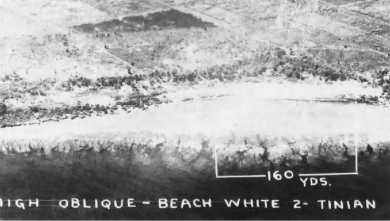
The 4th was designated the assault division for Tinian. The beaches were not wide enough to accommodate battalions landing abreast, much less divisions. Instead, the assault troops would land by columns—squads, platoons, and companies.
The 2d Division would follow on5 after taking part in the massive feint off the beaches of Tinian Town, hoping to tie down the main Japanese defense forces and spring the surprise of a landing over the lightly defended northern beaches.
To give the 4th more punch immediately after landing, the 2d was stripped of some of its firepower, such as tank and artillery units. It would, accordingly, be at the lowest strength at Tinian of any Marine division involved in an amphibious operation in World War II.
Despite these additions, the 4th, too, would be understrength—“skinny” was the descriptive word used by Lieutenant Colonel Justice M. “Jumping Joe” Chambers, commander of the 3d Battalion, 25th Marines, who was to earn a Medal of Honor in the Iwo Jima operation little more than six months later. The division’s infantry battalions had received only one replacement draft after the Saipan fighting. At full strength they averaged 880 men; at Tinian the average strength was down by more than 35 percent to 565.
For all these reasons—combat fatigue, heavy losses during previous weeks and months, and understrength units—the Marines on Tinian would play a cautious game. Admiral Turner had said he would give them two weeks to seize the island. Major General Harry Schmidt, who relieved Lieutenant General Holland M. Smith as VAC commander, promised to get it done in 10 days. In the event, the island was secured after nine days. In retrospect, analysts say the operation could have been finished off sooner by more aggressive tactics. Time, however, was no great factor; the relatively slow pace of the operation probably kept casualties at a minimum and reduced the probabilities of troop fatigue. Tinian was easy on the eyes, but the heat and humidity were brutal, the cane fields were hard going, and it was the season of monsoons.
The first troop ships moved out of Saipan’s Charan Kanoa harbor at 0330, 24 July. They were the transports Knox, Calvert, Fuller, Bell, Heywood, and John Land. They were carrying the 2d and 8th Marines (infantry regiments) of the 2d Marine Division on a mission of deception that turned out to be far bloodier than the White Beach landings and far bloodier than anyone had anticipated. They had a muscular escort—the battleship Colorado, the light cruiser Cleveland, and the destroyers Ramey, Norman Scott, Wadleigh, and Monssen.
The convoy moved into Sunharon Harbor opposite Tinian Town just before dawn. A few minutes after 0600, the Calvert began lowering its landing craft and by 0630 all 22 of its boats were in the water. Marines climbed down the cargo nets. Within a half hour, 244 Navy and Army planes began strafing and bombing6 runs paying particular attention to Tinian Town. Shells and rockets from battleships, heavy and light cruisers, destroyers, and 30 gunboats saturated the beaches. The massed artillery battalions on southern Saipan thundered in with their 105s and 155s.
After a half-hour of this furious bombardment, the LCVPs (landing craft, vehicle and personnel) from Calvert began their run toward the beach at Tinian Town, receiving heavy artillery and mortar fire from the shore. Admiral Hill, seeking to avoid casualties, ordered the boats to withdraw and reform. A second run started and immediately drew fire from the shore; several boats were sprayed with shell fragments. But they continued on to within 400 yards of the beach before turning back.
While the small boats engaged in this maneuver, the battleship Colorado came under fire at a range of 3,200 yards from two 6-inch naval guns near Tinian Town, guns that had gone undetected during the weeks of preinvasion surveillance and preparatory fires. Within 15 minutes, the Japanese gunners scored 22 direct hits on Colorado and six direct hits on the destroyer Norman Scott, which was attempting to protect the battleship. Casualties among the crews and Marine detachments on the two ships were heavy: 62 killed and 223 wounded. Ten Marines were among the dead, 31 were among the wounded. Colorado was through for the day and limped off back to Saipan. The Japanese battery survived for7 four more days until destroyed by the battleship Tennessee.
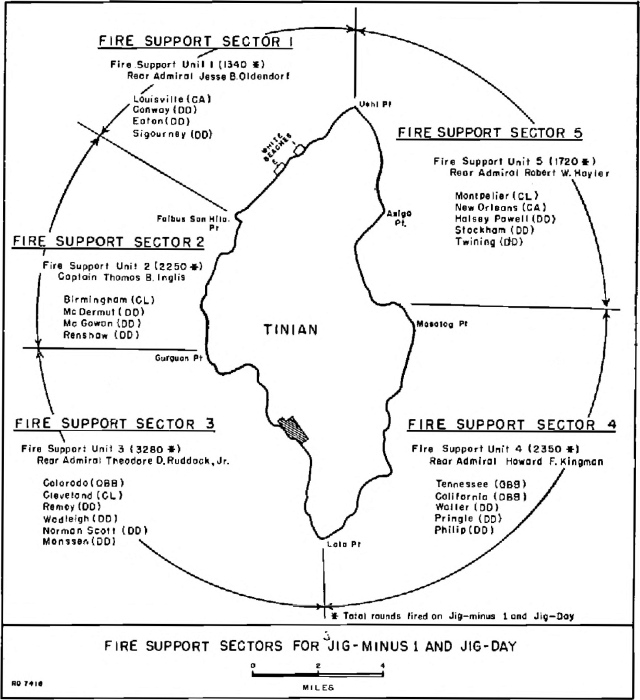
The losses sustained by the two ships exceeded those suffered that day by the Marine landing force on the northwestern beaches. But the feint served its purpose. It froze in place around Tinian Town a whole battalion of the 50th Infantry Regiment and various elements of the 56th Naval Guard Force. And it convinced the Japanese commander, Colonel Kiyochi Ogata, that he had thwarted an invasion. His message to Tokyo described how his forces had repelled 100 landing barges.
These “barges” were reloaded on the Calvert at 1000 and the convoy steamed north to the White Beaches where 4th Division troops had landed after a mishap in their planning. An underwater demolition team using floats carrying explosives swam to White Beach 2 shortly before dawn to blast away boulders and destroy beach mines. The mission failed because of a squall. The floats scattered, the explosives were lost and a few hours later, Marines paid a price for this aborted mission.
To compensate for the failure of the UDT team, fire support ships lying off the White Beaches—the battleships California and Tennessee, the heavy cruiser Louisville, and four destroyers—blasted away at the landing areas. Air strikes were then ordered at about 0630 and observers claimed that five of the 14 known beach mines had been destroyed. A battery of 155mm “Long Tom” guns on Saipan fired smokeshells at the Japanese command post on Mount Lasso and also laid smoke in the woods and on the bluffs just beyond the beaches to obstruct Japanese observation.
The assault plan assigned White Beach 1 to the 24th Marines and White Beach Two to the 25th. In the vanguard for the 24th was Company E of the 2d Battalion—200 men commanded by Captain Jack F. Ross, Jr. Company A of the 1st Battalion, commanded by Captain Irving Schechter, followed and by 0820 the entire 2d Battalion, commanded by Major Frank A. Garretson, was ashore.
Almost simultaneously, two battalions of the 25th Marines loaded into 16 LVTs landed in columns of companies on White Beach 2. The 2d Battalion under Lieutenant Colonel Lewis C. Hudson, Jr., was on the right; the 3d Battalion (Lieutenant Colonel Chambers) was on the left.
The units of the 24th, loaded into 24 LVTs, crossed the line of departure—3,000 yards offshore—at 0717. Ahead of them, 30 LCIs (landing craft, infantry) and a company of the 2d Armored Amphibian Battalion, commanded by Lieutenant Colonel Reed M. Fawell, Jr., raked the beaches with barrage rockets and automatic cannon fire. On the 26-minute run to the beach, the troop-laden LVTs took scattered and ineffectual rifle and machine gun fire.
At White 1, members of a small Japanese beach detachment, holed up in caves and crevices, resisted the landing with intense small arms fire. But they were silenced quickly by Company E gunners.
Within an hour, the entire 1st and 2d Battalions of the 24th were ashore on White 1, preparing to move inland. The 2d Battalion encountered sporadic artillery, mortar, and small arms fire during the first 200 yards of its advance. After that, Garretson later said, the battalion had a “cake walk” for the rest of the day gaining 1,400 yards and reaching its O-1 line objective by 1600. He occupied the western edge of Airfield No. 3 and cut the main road linking Airfield No. 1 with the east coast and southern Tinian. Only occasional small arms fire was encountered before the battalion dug in for the night.
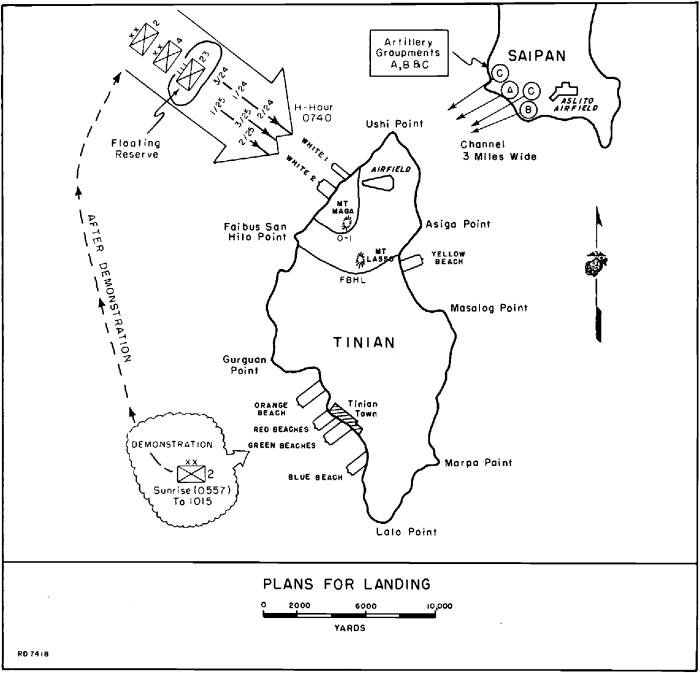
On Garretson’s left, the 1st Battalion, commanded by Lieutenant Colonel Otto Lessing, was slowed by heavy fires from cave positions and patches of heavy vegetation. Flamethrower tanks were sent up against these positions, but the Japanese held on. As a result, Lessing pulled up late in the afternoon 400 yards short of his objective. This left a gap between his perimeter and Garretson’s. To fill it, the regiment’s 3d Battalion, waiting in reserve at the beach, was called up.
Almost simultaneously, the 25th ran into problems. The beach and surrounding area had been methodically seeded with mines which neither UDT teams nor offshore gunners had been able to destroy. It took six hours to clear them out and in the process three LVTs and a jeep were blown up. The beach defenses also included a sprinkling of booby traps which had to be dealt with—watches and cases of beer, for example, all wired to explode in the hands of careless souvenir hunters.
Behind the beach, troops from Ogata’s 50th Regiment put up a vigorous defense with mortars, anti-tank and anti-boat guns, and other automatic weapons emplaced in pillboxes, caves, fortified ravines, and field entrenchments. Two 47mm guns in particular kept the Marines back on their heels. They finally bypassed these troublesome positions. Later waves took them out, leaving 50 dead Japanese in the gunpits.
The 3d Battalion commander, Lieutenant Colonel Chambers, later remembered a lot of confusion on the beach, “the confusion you [always] get when you land, of getting the organization together again.” One of his company commanders, for example, was killed a half-hour after landing10 and it took a while to get a replacement on scene and up to speed. Then there was the problem of the mines and a problem with artillery fire from the Japanese command post on Mount Lasso, two-and-a-half miles away.
By late afternoon, Chambers’ battalion had reached its objective 1,500 yards inland in the center of the line and had tied in on its left flank with Garretson of the 24th. The other battalions of the 25th came up short of their O-1 line, creating before sundown a crescent-shaped beachhead 3,000 yards wide at the shoreline and bulging inland to a maximum depth of 1,500 yards.
The day’s greatest confusion surrounded the landing of the 23d Marines. The regiment had been held on LSTs (landing ships, tank) in division reserve during the landing of the 24th and 25th. At 0730, the troops were ordered below to board LVTs parked cheek to jowl on the tank decks. Their engines were running, spewing forth carbon monoxide. Experience had shown that troops cooped up under these conditions for more than 30 minutes would develop severe headaches, become nauseous, and begin vomiting.
To avoid that problem and in the absence of a launch order, the regimental commander, Colonel Louis R. Jones, soon unloaded his men and sent them topside. They returned to the tank decks at 1030 when an order to load and launch finally was received. The regiment debarked and eventually got ashore beginning at 1400 despite an incredible series of communication breakdowns in which Jones at crucial times was out of touch with the division and his battalions.
In addition to botched radio communications, Jones was stuck in an LVT with a bad engine; it took him seven hours to get ashore with his staff, leading to a division complaint about the tardiness of his regiment. The division noted that “fortunately no serious harm was done by [the] delay,” but at the end of the operation Jones left the division. He was promoted to brigadier general and assigned as assistant division commander of the 1st Marine Division for the Okinawa landings.
A similar muck-up occurred involving the 2d Marine Division. After the feint at Tinian Town, the division sailed north and lay offshore of the White Beaches through the11 day. At 1515, the landing force commander, Major General Harry Schmidt, ordered a battalion from the 8th Marines to land at White Beach to back up the 24th Marines. Schmidt wanted the battalion ashore at 1600. Because of communication and transport confusion the deadline was missed. It was 2000 when the unit entered in its log “... dug in in assigned position.”

TINIAN
24–26 JULY 1944
On the other hand, the big things had gone well in the morning and afternoon. By the standards of Tarawa and Saipan, casualties were light—15 dead, 225 wounded. The body count for the Japanese was 438. Despite drizzling rain, narrow beaches, and undiscovered mines, 15,600 troops were put ashore along with great quantities of materiel and equipment that included four battalions of artillery, two dozen half-tracks mounting 75mm guns, and 48 medium and 15 flame-throwing tanks which found the Tinian terrain hospitable for tank operations. The tanks had gotten into action early that morning, leading the 24th in tank-infantry attacks. They also had come to the aid of the 23d Marines as that regiment moved inland to take over the division’s right flank. The beachhead itself was of respectable size, despite the failure of some units to reach their first-day objectives. It extended inland nearly a mile and embraced defensible territory. On the whole, it had not been a bad day’s work.
At about 1630, the 4th Division commander, General Cates, ordered his forces to button up for the night. A nighttime counterattack was expected. Barbed wire, preloaded on amphibian vehicles (DUKWs), was strung all along the division front. Ammunition was stacked at every weapons position. Machine guns were emplaced to permit interlocking fields of fire. Target areas were assigned to mortar crews. Artillery batteries in the rear were registered to hit probable enemy approach routes and to fire illuminating shells if a lighted battlefield was required. Of great importance, as it turned out, was the positioning up front of 37mm guns and cannister ammunition (antipersonnel shells which fired large pellets for close-in fighting); in the night fighting that followed, they inflicted severe losses on the enemy.
As the troops dug in to await whatever the night would bring, the 24th Marines, backed up by the 1st13 Battalion, 8th Marines, occupied the northern half of the defensive crescent. The 25th and a battalion of the 23d occupied the southern half of the crescent with the remainder of the 23d in reserve. On the beaches in the rear, artillery battalions from the 10th and 14th Marines, engineer battalions, and other special troops were on alert.
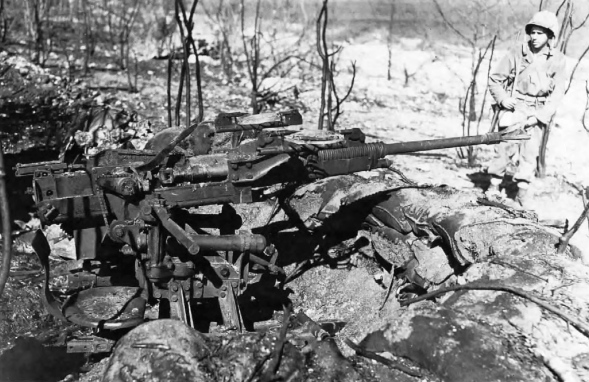
Department of Defense Photo (USMC) 87701
By the time the assault waves landed, most, if not all, Japanese beach defense weapons had been destroyed by the preinvasion bombardments. This Japanese navy-type 25mm machine cannon was knocked out before it could disrupt the landings.
The Japanese, meanwhile, were preparing for their counterattack. Because of shattered communications lines, it could not be a coordinated operation. Units would act on their own under Colonel Ogata’s general order of 28 June to “destroy the enemy on beaches with one blow, especially where time prevents quick movement of forces within the island.”
Even enemy weapons, such as this Japanese 120mm type 10 naval dual-purpose gun located not-too-far inland from the invasion beaches, was put out of action, but not before it, and two 6-inch guns, hit the battleship Colorado (BB 45) and destroyer Norman Scott (DD 690) causing casualties before being destroyed.
Department of Defense Photo (USMC) 91349
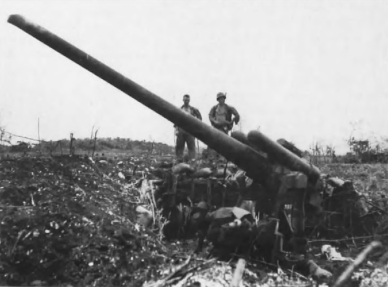
They had on the left or northern flank of the Marine lines 600 to 1,000 naval troops at the Ushi Point airfields. Near Mount Lasso, opposite14 the center of the Marine lines, were two battalions of the 50th Infantry Regiment and a tank company, about 1,500 men all told. On the west coast, facing the Marine right flank, were about 250 men from an infantry company of the 50th Regiment, a tank detachment and an anti-tank squad.
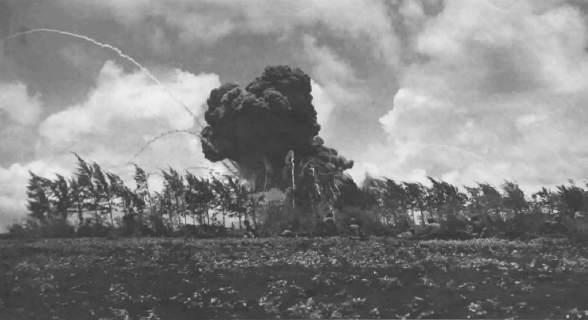
Department of Defense Photo (USMC) 87298
Attacking Marines hold up their advance in the face of an exploding Japanese ammunition dump after an attack by Navy planes supporting the drive across Tinian. Note the trees bent over by the force of shock waves caused by the eruption.
South of Mount Lasso, nearly six miles from the White Beaches, was the Japanese Mobile Counterattack Force—a 900-man battalion of the 135th Infantry Regiment, equipped with new rifles and demolition charges. Its journey toward the northwestern beaches and the Marine lines was perilous. All movements in daylight were under air surveillance and vulnerable to American fire power. But the battalion set out under its commander—a Captain Izumi—and was hit on several occasions by unobserved artillery and naval gunfire. Izumi pushed on and got to his objective through skillful use of terrain for concealment. At 2230 he began probing the center of the Marine line where the 2d Battalion, 24th Marines under Garretson was tied in with the 3d Battalion under Chambers.
“While most of these Japanese crept along just forward of the lines,” Carl Hoffman wrote, “... a two-man reconnaissance detail climbed up on a battered building forward of the 24th Marines and audaciously (or stupidly) commenced jotting notes about, or drawing sketches of, the front lines. This impudent gesture was rewarded with a thundering concentration of U.S. artillery fire.”
Amphibian tractors line up waiting to discharge their Marine passengers on the beach. The almost complete devastation of Japanese beachhead defenses, which was not entirely expected by the Marines, permitted this peaceful combat landing.
Department of Defense Photo (USMC) 93379
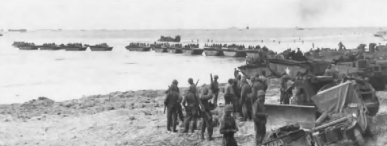
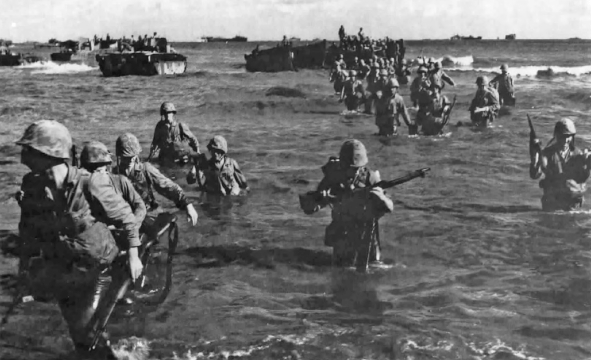
Department of Defense Photo (USMC) 88088
While some Marines were deposited “feet dry” beyond the shoreline of the beaches, others had to land “feet wet” wading ashore in the shallows from the amtracs which brought them in from the attack transports seen in the background.
Although frontline Marines appreciated the support of the 1st and 2d Provisional Rocket Companies’ truck-mounted 4.5-inch rocket launchers, they always dreaded the period immediately following a barrage. The dust and smoke thrown up at that time served as a perfect aiming point for enemy artillery and mortars which soon followed. Notice the flight of rockets in the upper left hand section of the picture.
Department of Defense Photo (USMC) 92269
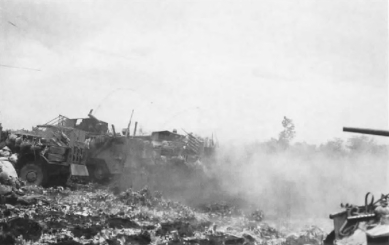
Chambers had a vivid memory of that night:
There was a big gully that ran from the southeast to northwest and right into the western edge of our area. Anybody in their right mind could have figured that if there was to be any counterattacks, that gully would be used....
During the night ... my men were reporting that they were hearing a lot of Japanese chattering down in the gully....15 They hit us about midnight in K company’s area. They hauled by hand a couple of 75mm howitzers with them and when they got them up to where they could fire at us, they hit us very hard. I think K company did a pretty damn good job but ... about 150, 200 Japs managed to push through [the 1,500 yards] to the beach area....
When the Japs hit the rear areas, all the artillery and machine guns started shooting like hell. Their fire was coming from the rear and grazing right up over our heads.... In the meantime, the enemy that hit L company was putting up a hell of a fight within 75 yards of where I was and there wasn’t a damn thing I could do about it.
Over in K company’s area ... was where the attack really developed. That’s where [Lt.] Mickey McGuire ... had his 37mm guns on the left flank and was firing cannister. Two of my men were manning a machine gun [Cpl Alfred J. Daigle and Pfc Orville H. Showers].... These two lads laid out16 in front of their machine gun a cone of Jap bodies. There was a dead Jap officer in with them. Both of the boys were dead.
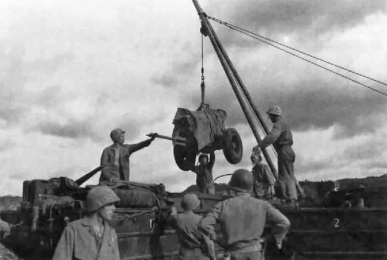
Department of Defense Photo (USMC) 87645
For Tinian, as in the Marshall Islands and the Saipan and Guam operations, DUKWs (amphibian trucks) were loaded with artillery pieces and ammunition at the mount out area. At the objective beaches, they were driven ashore right to the designated gun emplacements enabling the gun crews to get their weapons laid in and firing quickly. Here, an A-frame unloads a 75mm pack howitzer from an Army DUKW.
A Marine combat correspondent, described this action:
[Showers and Daigle] held their fire until the Japanese were 100 yards away, then opened up. The Japanese charged, screaming, “Banzai,” firing light machine guns and throwing hand grenades. It seemed impossible that the two Marines—far ahead of their own lines—could hold on.... The next morning they were found slumped over their weapons, dead. No less than 251 Japanese bodies were piled in front of them.... The Navy Cross was awarded posthumously to Daigle and the Silver Star posthumously to Showers.
Just before daybreak, Chambers recalled, two tank companies showed up, commanded by Major Robert I. Neiman. They “wanted to get right at the enemy” and Chambers sent them off to an area held by Companies K and L. Neiman returned in about a half hour and said, “You don’t need tanks. You need undertakers. I never saw so many dead Japs.”
On the night of 24–25 July, a Japanese counterattack accompanied by tanks failed completely with heavy losses. Here a Marine inspects the enemy dead near a destroyed tank. Note the placement of the bullet holes in the helmets in the ditch.
Department of Defense Photo (USMC) 91047

Another large contingent of Japanese troops was “stacked up” by17 the 75mm pack howitzer gunners of Battery D of the 14th Marines, supported by the .50-caliber machine guns of Batteries E and F: “They literally tore the Japanese ... to pieces.” Altogether about 600 Japanese were killed in their attack on the center.
On the left flank, 1st Battalion, 24th Marines, came under attack at 0200 from about 600 Special Naval Landing Force troops out of the barracks at the Ushi Point airfields. Company A, hit so hard it was reduced at one point to only 30 men with weapons, was forced to draw reinforcements from engineers, corpsmen, communicators, and members of the shore party. Illumination flares were fired over the battlefield, allowing the Marines to use 37mm cannister shells, machine gun fire, and mortars to good effect. The fight continued until dawn when medium tanks from the 4th Tank Battalion lumbered in to break up the last attacking groups. At that point, many Japanese began using their grenades to commit suicide.
As the sun rose, 476 Japanese bodies were counted in this sector of the defensive crescent, most of them in front of the Company A position.
The last enemy attack that night hit the right or southern flank of the Marines beginning at 0330 when six Japanese tanks (half of the Japanese tank force on Tinian) clattered up from the direction of Tinian Town to attack the 23d Marines position. They were met by fire from Marine artillery, anti-tank guns, bazookas, and small arms. Lieutenant Jim Lucas, a professional reporter who enlisted in the Marine Corps shortly after the attack on Pearl Harbor and was commissioned in the field, was there:
The three lead tanks broke through our wall of fire. One began to glow blood-red, turned crazily on its tracks and careened into a ditch. A second, mortally wounded, turned its machine guns on its tormentors, firing into the ditches in a last desperate effort to fight its way free. One hundred yards more and it stopped dead in its tracks. The third tried frantically to turn and then retreat, but our men closed in, literally blasting it apart.... Bazookas knocked out a fourth tank with a direct hit which killed the driver. The rest of the crew piled out of the turret screaming. The fifth tank, completely surrounded, attempted to flee. Bazookas made short work of it. Another hit set it afire and its crew was cremated.
The sixth tank was chased off, according to Colonel Jones, by a Marine driving a jeep. Some appraisers of this action believe only five tanks were involved. In any case, the destruction of these tanks did not end the fight on the right flank. Infantry units of the 50th Regiment continued to attack in the zone of 2d Battalion, 23d Marines. They were repulsed and killed in great numbers, largely through the effective use of 37mm anti-tank guns using cannister shot. In “the last hopeless moments of the assault,” Hoffman wrote, “some of the wounded Japanese destroyed themselves by detonating a magnetic tank mine which produced a terrific blast.”
A line of skirmishers was the formation normally used at Tinian even where there was no enemy contact. A platoon from the 2d Marines pushes forward while an observation plane (OY) circles overhead. High ground in the distance is part of a long spine extending straight south from Mount Lasso, an objective to be taken.
Marine Corps Historical Collection
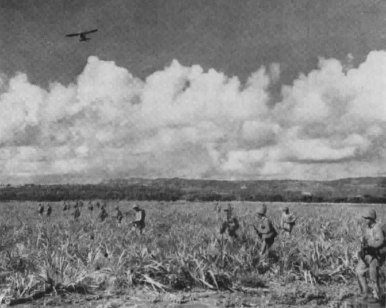
From the Japanese standpoint, the night’s work had been a disaster: 1,241 bodies left on the battlefield; several hundred more may have been carted away during the night. Fewer than 100 Marines were wounded or killed. “The loss of these [Japanese] troops,” the historian Frank Hough has written:
... broke the back of the defense of Tinian. With their communications shattered by sustained fire from Saipan and increasing fire from Tinian itself ... the survivors were capable of only the weakest, most dazed sort of resistance.... Now and again during the next seven days, small groups took advantage of the darkness to [launch night attacks], but for the most part they simply withdrew in18 no particular order until there remained nowhere to withdraw.
That was a common judgment after the Tinian battle had ended. But at the time, according to the 4th Division intelligence officer, Lieutenant Colonel Gooderham McCormick, a Marine Reserve officer who later became mayor of Philadelphia, things were not so clear: “We still believed [after the counterattack] the enemy capable of a harder fight ... and from day to day during our advance expected a bitter fight that never materialized.”
Nevertheless, a lot of hard work lay ahead. One of the most demanding tasks was the simple but exhausting job of humping through cane fields in terrific heat, humidity, and frequent monsoon downpours, fearful not only of sniper fire, mines, or booby traps, but fearful as well of fires that could sweep through the cane fields, incinerating anyone in their path.
Lieutenant Colonel William W. “Bucky” Buchanan was the assistant naval gunfire officer for the 4th Division at Tinian. His career later took him to Vietnam. After his retirement as a brigadier general he recalled the Tinian campaign:
We used the same tactics on Tinian that we did on Saipan: that is, a hand-holding, linear operation, like a bunch of brush-beaters, people shooting grouse or something, the idea being to flush out every man consistently as we go down, rather than driving down the main road with a fork and cutting this off and cutting this off in what I call creative tactics, you see. But this was the easiest thing and the safest thing to do. And who can criticize it? It was successful. Here, again, what little resistance was left was pushed into the end of the island ... and quickly collapsed.
The grouse-shooting metaphor is simplistic but even the 4th Division commander, Major General Clifton B. Cates, thought the campaign had its sporting aspects: “The fighting was different from most any that we had experienced because it was good terrain.... It was a good clean operation and I think the men really enjoyed it.”
Before the “brush beating” could19 begin in proper order, three things needed to be achieved. First, the 2d Marine Division had to be put ashore. This task was completed on the morning of 26 July—Jig plus 2.
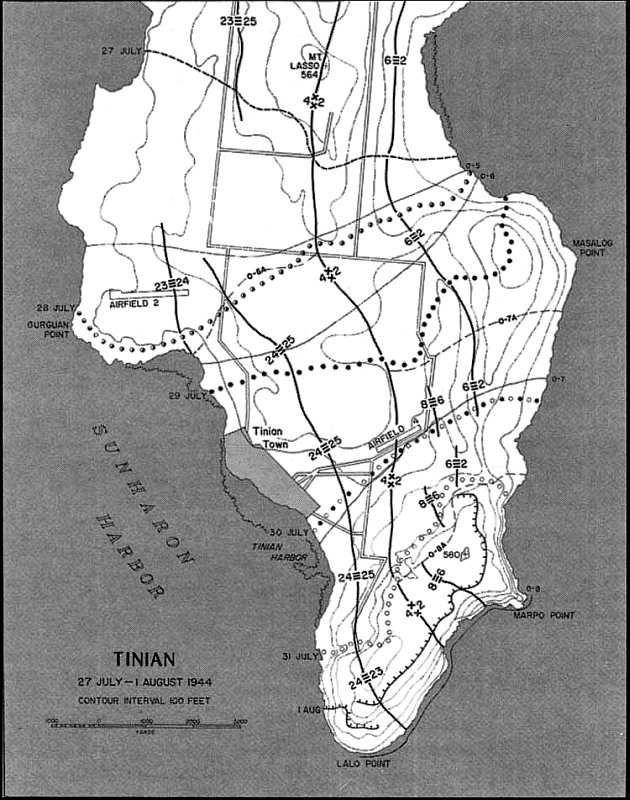
TINIAN
27 JULY–1 AUGUST 1944
Second, Japanese stragglers and pockets of resistance in the island’s northern sector had to be squashed. That job, for all practical purposes, was pretty well completed on the 26th as the 2d Division swept across the Ushi Point airfields, reached the east coast, and made a turn to the south. (Two days later, Seabees had the Ushi Point fields in operation for Army P-47 Thunderbolt fighters). Also on the 26th, the 4th Division had seized Mount Maga in the center of the island and had forced Colonel Ogata and his staff to abandon their command post on Mount Lasso which fell to the Marines without a struggle.
The third objective—to create for the drive south a skirmish line of infantry and tanks stretching all the way across the island—was also accomplished on the 26th. The 4th Division lined up in the western half of the island with the 23d Marines on the coast, the 24th in the center, and the 25th on the left flank. The 2d Division lined up with the 2d Marines on the east coast and the 6th Marines in the center, tied in to the 25th. The 8th Marines remained in the north to mop up.
Tramping the cane was a tiring work, especially when the direction of the advance did not parallel the rows of the fields. Each stalk was strong enough to trip a man careless about where he stepped. Advancing through such a field was fraught with danger, also, from hidden trip wires attached to demolitions, and from dug-in Japanese. In addition, the dry cane fields could easily catch fire and trap the Marines.
Marine Corps Historical Collection
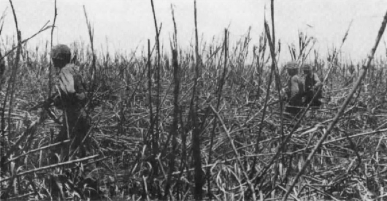
All this was accomplished with only minor casualties. For 26 July, for example, the 2nd Division reported two killed and 14 wounded. The heaviest losses since the first day and night of fighting had been sustained by the 14th Marines, the 4th Division’s artillery regiment, in the hours following the Japanese counterattack. An enemy shell hit the 1st Battalion’s fire direction center killing the battalion commander (Lieutenant Colonel Harry J. Zimmer), the intelligence officer, the operations officer, and seven other staff members; 14 other Marines at the battalion headquarters were wounded. Virtually all20 of the casualties sustained by that regiment during the Tinian campaign were taken on this single day, 25 July: 13 of the 14 killed, and 22 of the 29 wounded.
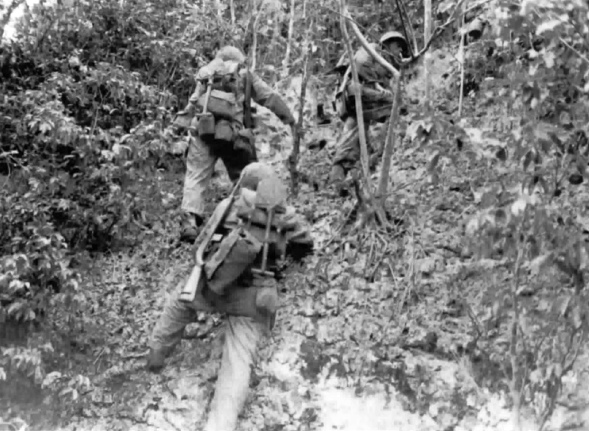
Department of Defense Photo (USMC) 87900
Marines of the 2d Division find some of the most difficult terrain on Tinian as they move up towards the top of Mount Lasso, one of the highest points on the island. Tinian, for the most part, was flat and level, and was under cultivation.
On the morning of 27 July, the “brush beating” drive to the south began in earnest. General Schmidt’s plan for the first two days of the drive alternated the main thrust between the two divisions. In the official history of the operation, the tactic was likened to “a man elbowing his way through the crowd,” swinging one arm and then the other.
The 2d Division got the heavier work on the 27th. XXIV Corps Artillery, firing from southern Saipan, softened up suspected enemy positions early in the morning and the division jumped off at 0730. It advanced rapidly, harassed by sporadic small arms fire. By 1345 it had reached its objective, gaining about 4,000 yards in just over six hours. The 4th Division moved out late in the morning against “negligible opposition,” reached its objective by noon and then called it a day. A Japanese prisoner complained to his captors, “You couldn’t drop a stick without bringing down artillery.”
The next morning, 28 July, the 4th got the “swinging elbow” job. It was now evident that the remaining Japanese defenders were rapidly retiring to the hills and caves along the southern coast. So opposition to the Marine advance was virtually nil. The 4th moved more than two miles in less than four hours with troops riding on half-tracks and tanks. Jumping off again early in the afternoon in “blitz fashion,” they overran the airfield at Gurguan Point, led by Major Richard K. Schmidt’s 4th Tank Battalion, and quit for the day at 1730 after gaining 7,300 yards—a little more than four miles. The 2d Division, given light duty under the Schmidt plan, moved ahead a few hundred yards, reached its objective in a couple of hours and dug in to await another morning.
General Cates later recalled how he spurred on his 4th Division troops: “I said, ‘Now, look here men, the [Hawaiian] island of Maui is waiting for us. See those ships out there? The quicker you get this over with, the quicker we’ll be back there.’ They almost ran over that island.”
On the 29th General Schmidt dropped the “elbowing” tactic and ordered both divisions to move as far and as fast as “practical.” Opposition21 had been so light that preparatory fires were canceled to save unneeded withdrawals from the diminishing supplies of artillery shells left on Saipan and to prevent “waste of naval gunfire on areas largely deserted by the enemy.”
The 2d Marines on the eastern terrain ran into pockets of resistance on a hill at Masalog Point; the 6th Marines encountered a 20-man Japanese patrol that attempted to penetrate the regiment’s lines after dark. The 25th took sniper fire as it moved through cane fields and later in the day engaged in a heavy firefight with Japanese troops fighting from dug-in positions. The Marines suffered several casualties and one of their tanks was disabled in this fight. But the resistance was overcome. The 24th Marines, operating near the west coast, ran into Japanese positions that included a series of mutually supporting bunkers. The 4th Tank Battalion reported that the area “had to be overrun twice by tanks” before resistance ended.
By nightfall, more than half of Tinian island was in Marine hands. Troops of the 4th Division could see Tinian Town from their foxholes. This was good for morale but the night was marred by the weather and enemy activity. A soaking rain fell through the night. Enemy mortar tubes and artillery pieces fired incessantly, drawing counterbattery fire from Marine gunners. There were probes in front of the 3d Battalion, 25th Marines, silenced by mortar and small arms fire; 41 Japanese bodies were found in the area at daylight.
On 30 July—Jig plus 6—Tinian Town became the principal objective of the 4th Division and, specifically, Colonel Franklin A. Hart’s 24th Marines. At 0735 all of the division’s artillery battalions laid down preparatory fires in front of the Marine lines. After 10 minutes, the firing stopped and the troops moved out. At the same time, two destroyers and cruisers lying in Sunharon Harbor off the Tinian Town beaches began an hour-long bombardment of slopes around the town in support of the Marines. The regiment’s 1st Battalion had advanced 600 yards when it came under heavy fire from caves along the coast north of the town. With the help of tanks and armored amphibians operating offshore this problem was overcome. Flamethrowing tanks worked over the caves, allowing engineers to seal them up with demolition charges. In one cave, a 75mm gun was destroyed.
The regiment entered the ruins of Tinian Town at 1420. Except for one Japanese soldier who was eliminated on the spot, the town was deserted. After searching through the rubble for snipers and documents, the Marines drove on to the O-7 line objective south of town. Their greatest peril was from mines and booby traps planted in beach areas and roads.
BGen Merritt A. Edson, (with binoculars) assistant division commander of the 2d Marine Division, follows the progress of his troops not far from the scene of action. Gen Edson was awarded the Medal of Honor for his heroism on Guadalcanal.
Department of Defense Photo (USMC) 87824
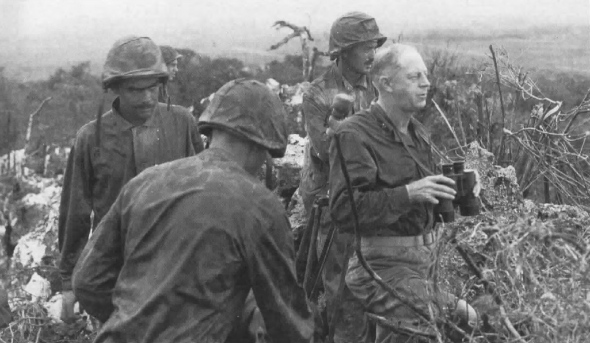
As the 24th moved south, the 25th Marines were seizing Airfield Number22 4 on the eastern outskirts of Tinian Town. The unfinished facility, a prisoner revealed, was being rushed to completion to accommodate relief planes promised by Tokyo. Only one aircraft was parked on the crushed-coral air strip—a small, Zero-type fighter. Flying suits, goggles, and other equipment were found in a supply room.
Enroute to the airfield, the 25th had taken light small arms fire and while crossing the airstrip was mortared from positions to the south. This was the 25th’s last action of the Tinian campaign. It went into reserve and was relieved that night by units of the 23d Marines and the 1st Battalion, 8th Marines.
The 2d Division, operating to the east of the 4th, ran into occasional opposition from machine gun positions and a 70mm howitzer. The 3d Battalion, 2d Marines, had the roughest time. After silencing the howitzer, it attacked across an open field and chased a Japanese force into a large cave where, with the help of a flame-throwing tank, 89 Japanese were killed and four machine guns were destroyed. Soon afterward the battalion came under mortar fire. “It is beyond my memory as to the number of casualties the 3d Battalion suffered at that time,” the unit’s commander, Lieutenant Colonel Walter F. Layer, later reported. “I personally rendered first aid to two wounded Marines and remember seeing six or seven Marines who were either wounded or killed by that enemy mortar fire. Tanks and half-tracks ... took the enemy under fire, destroying the enemy mortars.”
These were minor delays. The division reached its objective on time and was dug in by 1830. About 80 percent of the island was now in American hands.
The Japanese were now cornered in a small area of southeastern Tinian. The Marines “had advanced so rapidly that only four square miles of the island remained for safe firing by ships not supporting battalions [i.e., not with shore spotters],” according to a report on 30 July by Rear Admiral Harry W. Hill, commander of the Northern Attack Force.
The Marine commander for the operation, Major General Schmidt, saw the end in sight and late on the afternoon of 30 July issued an operations order calling on the divisions to drive all the way to the southeast coastline, seize all territory remaining in enemy hands and “annihilate the opposing Japanese.”
This was not a trifling assignment; it produced the heaviest fighting since the counterattack on the night of Jig Day. A Japanese warrant officer captured on 29 July estimated that 500 troops of the 56th Naval Guard Force and from 1,700 to 1,800 troops of the 50th Infantry Regiment remained in the southeastern area in a battle-ready condition. American intelligence estimates on 29 July, based on daily reports from the divisions, reckoned that 3,000 Japanese soldiers and sailors had been killed or taken prisoner up to that point. If that was the case, two-thirds of the nearly 9,000 Japanese defenders were still alive on the island.
The terrain occupied by the Japanese main force was rugged, difficult to reach or traverse and well-suited for defense. Outside of Tinian Town the gentle landscape ended, with the ground rising to a high plateau 5,000 yards long and 2,000 yards wide, with altitudes higher than 500 feet. The plateau was rocky and covered with thick brush. There were many caves. Along the east coast, the cliff walls rose steeply and appeared impossible to scale. The approaches to the plateau were blocked by many cliffs of this sort as well as by jungle growth. A road in the center of the plateau, leading to its top, was reported by a prisoner to be mined. The plateau was the enemy’s last redoubt.
As a Navy corpsman administers a bottle of plasma to a wounded Marine, the stretcher bearers wait patiently to carry him on board a landing craft which will evacuate him to a hospital ship offshore, where he will be given full treatment.
Department of Defense Photo (USMC) 87434
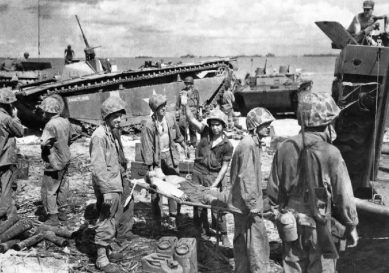
It became the object of the most intense bombardments any Japanese force had yet experienced to date in World War II. Marine artillery regiments on the island and the XXIV Corps Artillery on southern Saipan fired throughout the night of 30–31 July on the wooded clifflines the Marines would face during their assault.23 At 0600, the battleships Tennessee and California, the heavy cruiser Louisville, and the light cruisers Montpelier and Birmingham began the first of two sustained bombardments that morning. They fired for 75 minutes, then halted to allow a 40-minute strike on the plateau by 126 P-47s, North American Mitchell B-25 bombers, and Grumman Avenger torpedo bombers from the escort carrier Kitkun Bay. The planes dropped 69 tons of explosives before the offshore gunfire resumed for another 35 minutes. All told, the battleships and cruisers fired approximately 615 tons of shells at their targets. Artillerymen of the 10th Marines fired about 5,000 rounds during the night; 14th Marines gunners fired 2,000. The effect, one prisoner said, was “almost unbearable.”
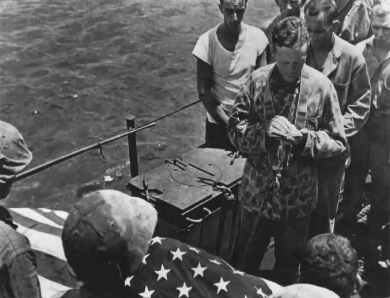
Marine Corps Historical Collection
Some badly wounded casualties died of their severe injuries after having been evacuated from Tinian. Those who succumbed to their wounds were buried at sea.
As you faced south on that morning, the regimental alignments from west coast to east coast were the 24th, 23d, 8th, 6th and 2d Marines. The task of the 24th was to clear out the western coastal area, with one battalion assigned to seizure of the plateau. The 2d Marines was to seal off the east coast at the base of the plateau. The 6th, 8th, and 23d Marines would assault the cliff areas and make their way to the top of the plateau.
Two Marines escort two apparently healthy, hearty, and willing Japanese prisoners to be turned in at the POW stockade in the rear of the fighting. Most of the prisoners taken on Tinian, however, were civilian workers rather than military men.
Department of Defense Photo (USMC) 91365
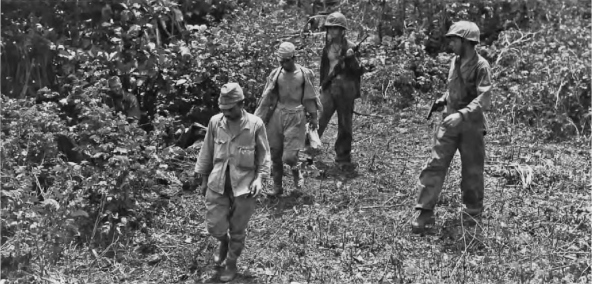
The 24th, jumping off with the 23d at 0830, moved into the coastal plain and immediately encountered brush and undergrowth so dense that tank operations were severely hampered. As compensation, armored amphibians lying offshore provided heavy fires against enemy beach positions and covered the regiment’s right flank as it made its way down the coast. A platoon-size Japanese beach unit launched a foolish counterattack on24 the 1st Battalion, 24th Marines at about 1000. The Japanese were annihilated. Later, flame-throwing tanks burned off brush and undergrowth concealing Japanese riflemen.
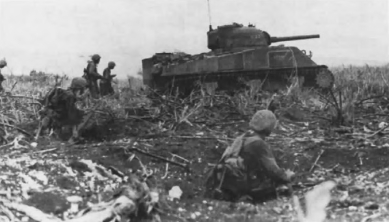
Department of Defense Photo (USMC) 152074
Tank-infantry tactics perfected in prior operations proved successful on Tinian as well. The riflemen served as the eyes of the armored vehicle and would direct the tank crewmen over a telephone mounted in a box on the rear of the tank.
On the regiment’s left flank, the 3d Battalion was in assault at the base of the plateau. It encountered minimal opposition until about 1600 when it began to receive rifle and machine gun fire from cliff positions. Tanks were called on but soon found themselves mired in a minefield and were held up for several hours while engineers cleared 45 mines from the area.
The 1st Battalion, 23d Marines, encountered similar troubles. As the regiment approached the plateau, it ran into dense small arms fire from two positions—a small village at the base of the cliff and from the cliff face itself. It also began receiving fire from a “large-caliber weapon.” Lacking tank support the Marines pressed forward, running a few yards, diving on their bellies, getting up, and advancing again. Medium tanks finally came up in search of this elusive and well-concealed weapon. One of them took six quick hits from the concealed position of this Japanese gun. A second tank was hit but in the process the enemy position was discovered: a camouflaged, concrete bunker housing a 47mm antitank gun and 20 troops, all of whom were killed.
MajGen Clifton B. Cates, center, visits the command post of 24th Marines commander Col Franklin A. Hart. On the left is LtCol Charles D. Roberts, S-3 of the 24th Marines. Gen Cates would become the 19th Commandant of the Marine Corps.
Department of Defense Photo (USMC) 143760

The 2d Battalion of the 23d had similar difficulties. After coming under fire from riflemen and machine gunners, one of its supporting tanks was disabled by a mine. After its crew was taken to safety by another tank, the disabled vehicle was seized by the Japanese and used as an25 armored machine gun nest. Other tanks soon took it out. The 23d also lost that day two 37mm guns and a one-ton truck belonging to the regiment’s half-track platoon. The guns and the vehicle got too far out front, came under heavy fire and were abandoned. A detail from the platoon later retrieved one of the guns, removed the breech block from the other one and brought back the .50-caliber machine gun from its mounting on the truck.
Tinian Town was made a shambles because U.S. commanders knew that the enemy was well emplaced, dug in, and expected landings on the beaches fronting the town. As a result, they directed a large share of the pre-Jig Day bombardment into the waterfront and surrounding area, thereby reinforcing Japanese beliefs that this is where the Marines would land.
Marine Corps Historical Collection
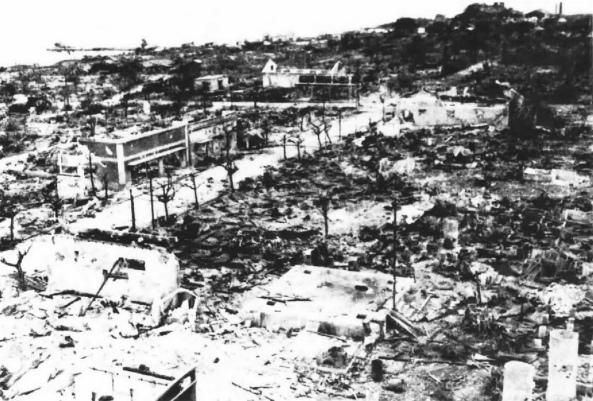
Late in the afternoon, the 1st Battalion, 23d Marines, and a company from the 2d Battalion gained a foothold on top of the plateau; the 3d Battalion soon followed. To their left, the 3d Battalion, 8th Marines, shrugged off small arms fire early in the day and reached the base of the cliff where it stalled for the night. The 1st Battalion had better luck. Company A made it to the top of the plateau at 1650, followed by a platoon from Company C. Soon after, the whole battalion was atop the hill. It was followed by Companies E and G of the 2d Battalion.
The Company G commander was Captain Carl W. Hoffman, who later wrote the definitive histories of the Saipan and Tinian campaigns. In an oral history interview, he described his own experiences on top of the plateau the night of 31 July:
By the time we got up there ... there wasn’t enough daylight left to get ourselves properly barbed-wired in, to get our fields of fire established, to site our interlocking bands of machine gun fire—all the things that should be done in preparing a good defense.
By dusk, the enemy commenced a series of probing attacks. Some Japanese intruded into our positions. It was a completely black night. So, with Japanese moving around in our positions, our troops became very edgy and were challenging everybody in sight. We didn’t have any unfortunate incidents of Marines firing on Marines ... [because they] were well-seasoned by this point....
As the night wore on, the intensity of enemy attacks started to build and build and build. They finally launched a full scale banzai attack against [our] battalion.... The strange thing the Japanese did here was that they executed one wave of26 attack after another against a 37mm position firing cannister ammunition....
That gun just stacked up dead Japanese.... As soon as one Marine gunner would drop another would take his place. [Eight of 10 men who manned the gun were killed or wounded]. Soon we were nearly shoulder-high with dead Japanese in front of that weapon.... By morning we had defeated the enemy. Around us were lots of dead ones, hundreds of them as a matter of fact. From then on ... we were able to finish the rest of the campaign without difficulty.... People have often said that the Tinian campaign was the easiest campaign ... in the Pacific....
For those Marines who were in that 37mm position up on the escarpment, Tinian had to be the busiest campaign within the Pacific war.

Marine Corps Historical Collection
A lone member of the 24th Marines, 4th Marine Division patrolling through the outskirts of Tinian Town, pauses at a torii of a Shinto shrine. The ruins about him give proof of the heavy shelling visited upon the town before the landing.
Hoffman had another lively experience before leaving the island. He was a trumpet addict and carried his horn with him all through the Pacific war:
For Tinian, I didn’t take any chances such as sending my horn ashore in a machine gun cart or a battalion ambulance. I had it flown over to me. One evening, my troops were in a little perimeter with barbed wire all around us on top of the cliff. My Marines were shouting in requests: “Oh, You Beautiful Doll” and “Pretty Baby” and others. While I was playing these tunes, all of a sudden we heard this scream of “banzai.” An individual Japanese soldier was charging right toward me and right toward the barbed wire. The Marines had their weapons ready and he must have been hit from 14 different directions at once. He didn’t get to throw [his] grenade.... I’ve always cited him as the individual who didn’t like my music. He was no supporter of my trumpet playing. But ... I even continued my little concert after we had accounted for him.
A final banzai attack on the night the 37mm guns had their big harvest, occurred in the early morning hours of 1 August. A 150-man Japanese force attacked the 1st Battalion, 28th Marines, on Hoffman’s left flank. After 30 minutes, the main thrust of the attack was spent and at dawn the Japanese withdrew; 100 bodies lay in an area 70 yards square in front of the position of Company E, 2d Battalion, 28th Marines. The 8th27 Marines took 74 casualties that night.
The following morning the two divisions went back to work. The 2d moved across the plateau toward its eastern cliffs, the 4th toward cliffs on the south and west. When they reached the escarpment’s edge, overlooking the ocean, their job was essentially done. At 1855, General Schmidt declared the island “secure,” meaning that organized resistance had ended. But not the killing. Hundreds of Japanese troops remained holed up in the caves pock-mocking the southern cliffs rising up from the ocean.
On the morning of 2 August, a Japanese force of 200 men sallied forth in an attack on the 3d Battalion, 6th Marines. After two hours of combat, 119 Japanese were dead. Marine losses included the battalion commander, Lieutenant Colonel John W. Easley. Shortly afterwards, the regiment’s 2d Battalion, led by Lieutenant Colonel Edmund B. Games, was hit by 100 Japanese, 30 of whom were killed before the unit withdrew.
Contacts of this kind continued for months. By the end of the year, Colonel Clarence R. Wallace’s 8th Marines, left on Tinian for mopping-up operations, had lost 38 killed and 125 wounded; Japanese losses were 500 dead.
Beginning on 1 August, there were large-scale surrenders by civilians leaving the caves in which they had taken refuge. Marine intelligence officers estimated that 5,000 to 10,000 civilians had been hiding out in the southeast sector.
This cliff was a formidable obstacle to movement on 31 July. Cutting practically across the entire island, it provided problems for both divisions. Here, 2d Division Marines climb the rocky slopes toward the flat plateau on top. The 1st and 2d Battalions, 8th Marines, spent a busy night (31 July–1 August) of the operation holding a road that curled up this slope.
Department of Defense Photo (USMC) 87898

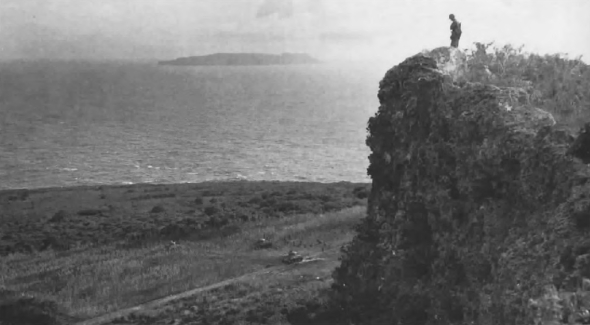
Department of Defense Photo (USMC) 94350
The end of the battle is in sight as troops of the 24th Marines and tanks of the 4th Tank Battalion comb across the coastal plateau at Tinian’s extreme southern end. The 23d Marines, whose zone ended at the top of the steep cliff seen in this picture, had to retrace its steps in order to reach the lowlands. Aguijan Island may be seen dimly in the misty background.
This 75mm pack howitzer, nicknamed “Miss Connie,” is firing into a Japanese-held cave from the brink of a sheer cliff in southern Tinian. The gun was locked securely in this unusual position after parts were hand-carried to the cliff’s edge.
Department of Defense Photo (USMC) 94660
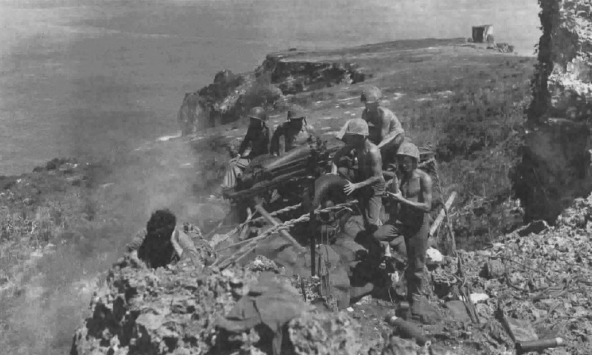
Marine Major General James L. Underhill, who took command of the island as military governor on 10 August, became responsible for the care and feeding of these civilians. The flow of civilian refugees began on August 1, he recalled:
About 500 came through immediately, the next day about 800, then a thousand and then two thousand and so on in increasing numbers until about 8,000 were in. The remaining 3,000 hid out in caves and dribbled in over a period of months. About 30 percent adult males, 20 percent adult females, and29 about 50 percent children. Many of them were in bad shape—hungry, wounded, ill and with few possessions beyond the clothes they were wearing.
It was estimated that about 4,000 civilians were killed in the bombardments of Tinian and in fighting on the island. On Saipan, Marines had been helpless to prevent mass suicides among the civilian population. They were more successful at Tinian. Unfortunate incidents occurred—civilians, for example, dying under Marine fire after wandering into the lines at night.
There were also suicides and ritual murders, as indicated in a report from the 23d Marines on 3 August:
Several freak incidents occurred during the day: (1) Jap children thrown [by their parents] over cliff into ocean; (2) [Japanese] military grouped civilians in numbers of 15 to 20 and attached explosive charges to them, blowing them to bits; (3) Both military and civilians lined up on the cliff and hurled themselves into the ocean; (4) Many civilians pushed over cliff by [Japanese] soldiers.
Efforts to prevent incidents of this kind were generally successful. Marines used amplifiers on land and offshore to promise good treatment to civilians and soldiers who would surrender peacefully. “Thousands of civilians,” Hoffman wrote, “many clad in colorful Japanese silk, responded to the promises—though it was plain from the expressions on their faces that they expected the worst.”
By 14 August the entire 4th Division had embarked on the long trip to its base camp on Maui. It had suffered30 in this brief operation more than 1,100 casualties, including 212 killed. Its next assignment would be Iwo Jima.
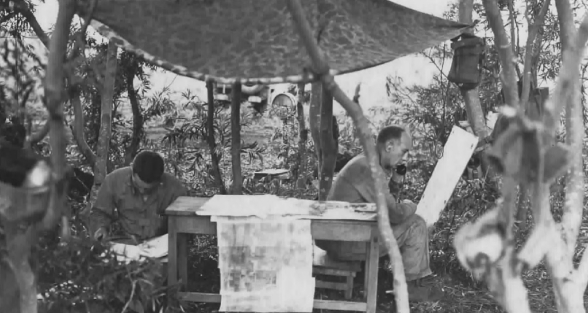
Department of Defense Photo (USMC) 87678
In an impromptu command post set up behind his 8th Marines, Col Clarence R. Wallace checks the progress of his frontline troops on a situation map. The overhead poncho provides some protection from Tinian’s constant rains.
The 2d Division remained in the Marianas, setting up a base camp on Saipan where the 2d and 6th regiments took up residence in mid-August. The 8th Marines remained on Tinian for mopping-up purposes until October 25, when the 2d and 3d Battalions moved to Saipan, leaving an unhappy 1st Battalion behind until its relief at the end of the year.
The campaign for Tinian had cost the division 760 casualties, including 105 killed. These numbers did not include casualties suffered after the island was “secured” on 1 August.
Japanese military losses, based on bodies counted and buried, totaled 5,000. Other thousands are assumed to have been sealed up in caves and underground fortifications. The number of prisoners taken was 250 by some counts and 400 by others.
It was not long after the initial landing that Marines encountered the civilian population of Tinian. Here Marines bathe a tiny Tinian girl after she and her family had been removed from a hillside dugout. Following the scrubbing, new clothes were found for the children and the entire family was taken to a place of safety in the rear.
Department of Defense Photo (USMC) 90441
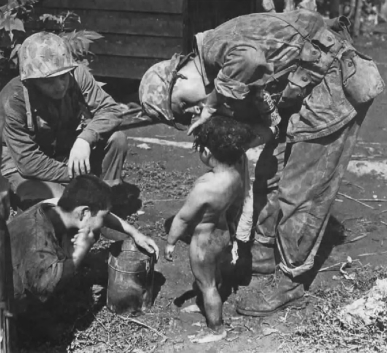
The capture of the Marianas gave the Army Air Corps the B-29 bases it needed for the bombing of Japan.31 They were located 1,200 nautical miles from the home islands of Japan, a distance ideal for the B-29 with its range of 2,800 miles. Tinian became the home for two wings of the Twentieth Air Force. Three months after the conquest of Tinian, B-29s were hitting the Japanese mainland. Over the next year, according to numbers supplied by the Air Force to historian Carl Hoffman, the B-29s flew 29,000 missions out of the Marianas, dropped 157,000 tons of explosives which, by Japanese estimates killed 260,000 people, left 9,200,000 homeless, and demolished or burned 2,210,000 homes.
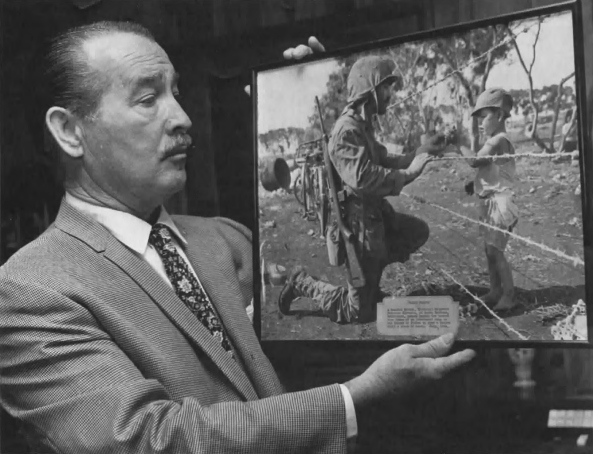
Department of Defense Photo (USMC) 419222
Former Marine Corps Combat Correspondent SSgt Federico Claveria looks at photograph of himself giving an interned Tinian child candy 25 years earlier. Claveria participated in the initial landings on Roi-Namur and Saipan also.
Top commanders gather for the flagraising on 3 August 1944 at the conclusion of Tinian operations. From left are RAdm Harry W. Hill; MajGen Harry Schmidt; Adm Raymond L. Spruance; LtGen Holland M. Smith; VAdm Richmond Kelly Turner; MajGen Thomas A. Watson; and MajGen Clifton B. Cates.
Marine Corps Historical Collection

Tinian’s place in the history of warfare was insured by the flight of Enola Gay on 6 August 1945. It dropped32 a nuclear weapon on Hiroshima. Two days later a second nuclear weapon was dropped on Nagasaki. The next day, the Japanese government surrendered.
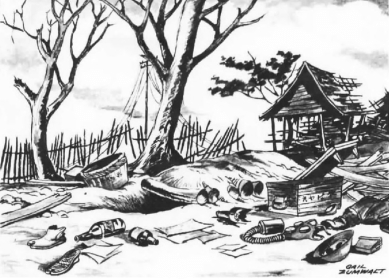
Marine Corps Combat Art Collection
“Japanese Backyard in Tinian Town,” by Gail Zumwalt
In his official history of the 2d Marine Division, Richard W. Johnston records the reaction when news of the surrender reached the division at its base on Saipan:
They looked at Tinian’s clean and rocky coast, at the coral boulders where they had gone ashore, and they thought of the forbidding coasts of Japan—the coasts that awaited them in the fall. “That Tinian was a pretty good investment, I guess,” one Marine finally said.
The anecdote may be apocryphal. The sentiment is historically true.
The hand salute in its various forms is rendered by those present as the colors are raised over Tinian on 1 August. At the extreme right is VAdm Richmond K. Turner; commander, Expeditionary/Northern Attack Force for the Tinian landings.
Department of Defense Photo (USMC) 152064
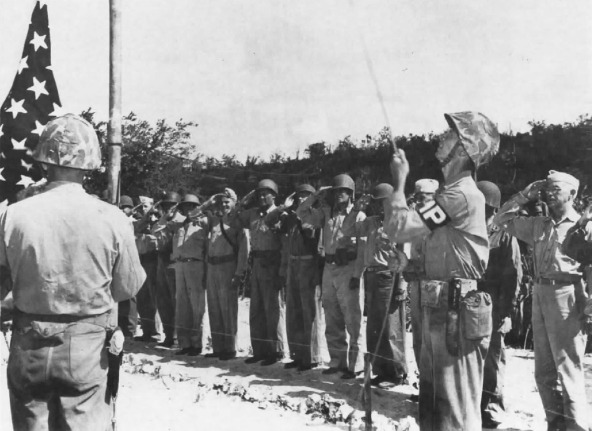
In addition to the official Marine Corps histories of the Tinian campaign, Lt John C. Chapin, The Fourth Marine Division in World War II (Washington, August, 1945); John Costello, The Pacific War (New York, 1981); John Dower, War Without Mercy: Race and Power in the Pacific War (New York, 1986); Maj Carl W. Hoffman, Saipan: The Beginning of the End (Washington, 1950); Maj Carl W. Hoffman, The Seizure of Tinian (Washington, 1951); Frank Olney Hough, The Island War: The U.S. Marine Corps in the Pacific (Philadelphia, 1947); Jeter A. Isely and Philip A. Crowl, The U.S. Marine Corps and Amphibious War (Princeton, 1951); Richard W. Johnston, Follow Me! The Story of the Second Marine Division in World War II (New York, 1948); Allen R. Millett, Semper Fidelis: The History of the United States Marine Corps (New York, 1991); J. Robert Moskin, The U.S. Marine Corps Story (Boston, 1992); Carl W. Proehl (ed.), The Fourth Marine Division in World War II (Nashville, 1988); Henry I. Shaw, Jr., Bernard C. Nalty, Edwin T. Turnbladh, Central Pacific Drive: History of U.S. Marine Corps Operations in World War II, vol III (Washington, 1966); Ronald H. Spector, Eagle Against the Sun (New York, 1985).
The transcripts of the following retired Marines interviewed for the Marine Corps Oral History Program reside in the Oral History Collection, Marine Corps Historical Center, Washington Navy Yard, Washington, D.C. Their roles at Tinian are as indicated: BGen William W. Buchanan, assistant naval gunfire officer, 4th Marine Division; Gen Clifton B. Cates, commanding general, 4th Marine Division; LtCol Justice M. Chambers, commanding officer, 3d Battalion, 25th Marines; MajGen Carl W. Hoffman, commanding officer, Company G, 2d Battalion, 8th Marines; Gen Robert E. Hogaboom, G-3, Northern Troops Landing Force; MajGen Louis R. Jones, commanding officer, 23d Marines; BGen Frederick J. Karch, S-3, 14th Marines; MajGen Wood B. Kyle, commanding officer, 1st Battalion, 2d Marines; MajGen William W. Rogers, chief of staff, 4th Marine Division; LtGen James L. Underhill, island commander, Tinian.
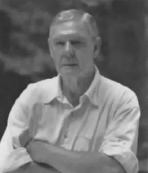
Richard Harwood, a journalist and news executive, retired as deputy managing editor of The Washington Post in 1988. He now writes an editorial column for The Post which is distributed nationally by the Los Angeles Times-Washington Post News Service. He served in the U.S. Marines from 1942 until 1946, and spent 30 months in the Pacific. As a radio operator in the V Amphibious Corps he participated in four operations, including Tinian.
In A Different War: Marines in Europe and North Africa, page 32 reports Adm Hewitt visited the cruiser “Helena (CL-50)” in spring 1946. This cruiser was sunk in 1943. The ship the admiral boarded was its successor, the heavy cruiser Helena (CA-75). On page 27 of Liberation: Marines in the Recapture of Guam, the 77th Infantry Division patrolled hills to the east, rather than to the west. The date of the action which merited a Medal of Honor for PFC Harold G. Epperson is 25 June 1944, not July, as stated on page 30 of Breaching the Marianas: The Battle for Saipan.
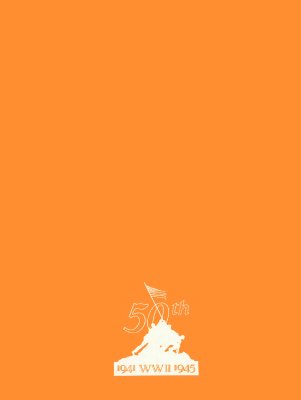
Punctuation, hyphenation, and spelling were made consistent when a predominant preference was found in this book; otherwise they were not changed.
Simple typographical errors and unbalanced quotation marks have been corrected.
To make this eBook easier to read, particularly on handheld devices, some images have been made relatively larger than in the original pamphlet, and centered, rather than offset to one side or the other; and some were placed a little earlier or later than in the original. Sidebars in the original have been repositioned between chapters and identified as “[Sidebar (page nn):”, where the page reference is to the original location in the source book. In the Plain Text version, the matching closing right bracket follows the last line of the Sidebar’s text and is on a separate line to make it more noticeable. In the HTML versions, that bracket follows the colon, and each Sidebar is displayed within a box.
Original text uses “Kiyochi Ogata” and “Kiyoshi Ogata” to refer to the same person.
Sidebar “Tinian Defense Forces” (originally on page 9): “Laslo Point” is shown as as “Lalo Point” on the maps in this book.
Page 27, illustration caption: “the rocky slopes” was misprinted as “rockly”; “operation” was misprinted as “operating”; “pock-mocking” was printed that way and has not been changed.
End of the Project Gutenberg EBook of A Close Encounter: The Marine Landing
on Tinian, by Richard Harwood
*** END OF THIS PROJECT GUTENBERG EBOOK A CLOSE ENCOUNTER ***
***** This file should be named 48969-h.htm or 48969-h.zip *****
This and all associated files of various formats will be found in:
http://www.gutenberg.org/4/8/9/6/48969/
Produced by Brian Coe, Charlie Howard, and the Online
Distributed Proofreading Team at http://www.pgdp.net (This
file was produced from images generously made available
by The Internet Archive/American Libraries.)
Updated editions will replace the previous one--the old editions will
be renamed.
Creating the works from print editions not protected by U.S. copyright
law means that no one owns a United States copyright in these works,
so the Foundation (and you!) can copy and distribute it in the United
States without permission and without paying copyright
royalties. Special rules, set forth in the General Terms of Use part
of this license, apply to copying and distributing Project
Gutenberg-tm electronic works to protect the PROJECT GUTENBERG-tm
concept and trademark. Project Gutenberg is a registered trademark,
and may not be used if you charge for the eBooks, unless you receive
specific permission. If you do not charge anything for copies of this
eBook, complying with the rules is very easy. You may use this eBook
for nearly any purpose such as creation of derivative works, reports,
performances and research. They may be modified and printed and given
away--you may do practically ANYTHING in the United States with eBooks
not protected by U.S. copyright law. Redistribution is subject to the
trademark license, especially commercial redistribution.
START: FULL LICENSE
THE FULL PROJECT GUTENBERG LICENSE
PLEASE READ THIS BEFORE YOU DISTRIBUTE OR USE THIS WORK
To protect the Project Gutenberg-tm mission of promoting the free
distribution of electronic works, by using or distributing this work
(or any other work associated in any way with the phrase "Project
Gutenberg"), you agree to comply with all the terms of the Full
Project Gutenberg-tm License available with this file or online at
www.gutenberg.org/license.
Section 1. General Terms of Use and Redistributing Project
Gutenberg-tm electronic works
1.A. By reading or using any part of this Project Gutenberg-tm
electronic work, you indicate that you have read, understand, agree to
and accept all the terms of this license and intellectual property
(trademark/copyright) agreement. If you do not agree to abide by all
the terms of this agreement, you must cease using and return or
destroy all copies of Project Gutenberg-tm electronic works in your
possession. If you paid a fee for obtaining a copy of or access to a
Project Gutenberg-tm electronic work and you do not agree to be bound
by the terms of this agreement, you may obtain a refund from the
person or entity to whom you paid the fee as set forth in paragraph
1.E.8.
1.B. "Project Gutenberg" is a registered trademark. It may only be
used on or associated in any way with an electronic work by people who
agree to be bound by the terms of this agreement. There are a few
things that you can do with most Project Gutenberg-tm electronic works
even without complying with the full terms of this agreement. See
paragraph 1.C below. There are a lot of things you can do with Project
Gutenberg-tm electronic works if you follow the terms of this
agreement and help preserve free future access to Project Gutenberg-tm
electronic works. See paragraph 1.E below.
1.C. The Project Gutenberg Literary Archive Foundation ("the
Foundation" or PGLAF), owns a compilation copyright in the collection
of Project Gutenberg-tm electronic works. Nearly all the individual
works in the collection are in the public domain in the United
States. If an individual work is unprotected by copyright law in the
United States and you are located in the United States, we do not
claim a right to prevent you from copying, distributing, performing,
displaying or creating derivative works based on the work as long as
all references to Project Gutenberg are removed. Of course, we hope
that you will support the Project Gutenberg-tm mission of promoting
free access to electronic works by freely sharing Project Gutenberg-tm
works in compliance with the terms of this agreement for keeping the
Project Gutenberg-tm name associated with the work. You can easily
comply with the terms of this agreement by keeping this work in the
same format with its attached full Project Gutenberg-tm License when
you share it without charge with others.
1.D. The copyright laws of the place where you are located also govern
what you can do with this work. Copyright laws in most countries are
in a constant state of change. If you are outside the United States,
check the laws of your country in addition to the terms of this
agreement before downloading, copying, displaying, performing,
distributing or creating derivative works based on this work or any
other Project Gutenberg-tm work. The Foundation makes no
representations concerning the copyright status of any work in any
country outside the United States.
1.E. Unless you have removed all references to Project Gutenberg:
1.E.1. The following sentence, with active links to, or other
immediate access to, the full Project Gutenberg-tm License must appear
prominently whenever any copy of a Project Gutenberg-tm work (any work
on which the phrase "Project Gutenberg" appears, or with which the
phrase "Project Gutenberg" is associated) is accessed, displayed,
performed, viewed, copied or distributed:
This eBook is for the use of anyone anywhere in the United States and
most other parts of the world at no cost and with almost no
restrictions whatsoever. You may copy it, give it away or re-use it
under the terms of the Project Gutenberg License included with this
eBook or online at www.gutenberg.org. If you are not located in the
United States, you'll have to check the laws of the country where you
are located before using this ebook.
1.E.2. If an individual Project Gutenberg-tm electronic work is
derived from texts not protected by U.S. copyright law (does not
contain a notice indicating that it is posted with permission of the
copyright holder), the work can be copied and distributed to anyone in
the United States without paying any fees or charges. If you are
redistributing or providing access to a work with the phrase "Project
Gutenberg" associated with or appearing on the work, you must comply
either with the requirements of paragraphs 1.E.1 through 1.E.7 or
obtain permission for the use of the work and the Project Gutenberg-tm
trademark as set forth in paragraphs 1.E.8 or 1.E.9.
1.E.3. If an individual Project Gutenberg-tm electronic work is posted
with the permission of the copyright holder, your use and distribution
must comply with both paragraphs 1.E.1 through 1.E.7 and any
additional terms imposed by the copyright holder. Additional terms
will be linked to the Project Gutenberg-tm License for all works
posted with the permission of the copyright holder found at the
beginning of this work.
1.E.4. Do not unlink or detach or remove the full Project Gutenberg-tm
License terms from this work, or any files containing a part of this
work or any other work associated with Project Gutenberg-tm.
1.E.5. Do not copy, display, perform, distribute or redistribute this
electronic work, or any part of this electronic work, without
prominently displaying the sentence set forth in paragraph 1.E.1 with
active links or immediate access to the full terms of the Project
Gutenberg-tm License.
1.E.6. You may convert to and distribute this work in any binary,
compressed, marked up, nonproprietary or proprietary form, including
any word processing or hypertext form. However, if you provide access
to or distribute copies of a Project Gutenberg-tm work in a format
other than "Plain Vanilla ASCII" or other format used in the official
version posted on the official Project Gutenberg-tm web site
(www.gutenberg.org), you must, at no additional cost, fee or expense
to the user, provide a copy, a means of exporting a copy, or a means
of obtaining a copy upon request, of the work in its original "Plain
Vanilla ASCII" or other form. Any alternate format must include the
full Project Gutenberg-tm License as specified in paragraph 1.E.1.
1.E.7. Do not charge a fee for access to, viewing, displaying,
performing, copying or distributing any Project Gutenberg-tm works
unless you comply with paragraph 1.E.8 or 1.E.9.
1.E.8. You may charge a reasonable fee for copies of or providing
access to or distributing Project Gutenberg-tm electronic works
provided that
* You pay a royalty fee of 20% of the gross profits you derive from
the use of Project Gutenberg-tm works calculated using the method
you already use to calculate your applicable taxes. The fee is owed
to the owner of the Project Gutenberg-tm trademark, but he has
agreed to donate royalties under this paragraph to the Project
Gutenberg Literary Archive Foundation. Royalty payments must be paid
within 60 days following each date on which you prepare (or are
legally required to prepare) your periodic tax returns. Royalty
payments should be clearly marked as such and sent to the Project
Gutenberg Literary Archive Foundation at the address specified in
Section 4, "Information about donations to the Project Gutenberg
Literary Archive Foundation."
* You provide a full refund of any money paid by a user who notifies
you in writing (or by e-mail) within 30 days of receipt that s/he
does not agree to the terms of the full Project Gutenberg-tm
License. You must require such a user to return or destroy all
copies of the works possessed in a physical medium and discontinue
all use of and all access to other copies of Project Gutenberg-tm
works.
* You provide, in accordance with paragraph 1.F.3, a full refund of
any money paid for a work or a replacement copy, if a defect in the
electronic work is discovered and reported to you within 90 days of
receipt of the work.
* You comply with all other terms of this agreement for free
distribution of Project Gutenberg-tm works.
1.E.9. If you wish to charge a fee or distribute a Project
Gutenberg-tm electronic work or group of works on different terms than
are set forth in this agreement, you must obtain permission in writing
from both the Project Gutenberg Literary Archive Foundation and The
Project Gutenberg Trademark LLC, the owner of the Project Gutenberg-tm
trademark. Contact the Foundation as set forth in Section 3 below.
1.F.
1.F.1. Project Gutenberg volunteers and employees expend considerable
effort to identify, do copyright research on, transcribe and proofread
works not protected by U.S. copyright law in creating the Project
Gutenberg-tm collection. Despite these efforts, Project Gutenberg-tm
electronic works, and the medium on which they may be stored, may
contain "Defects," such as, but not limited to, incomplete, inaccurate
or corrupt data, transcription errors, a copyright or other
intellectual property infringement, a defective or damaged disk or
other medium, a computer virus, or computer codes that damage or
cannot be read by your equipment.
1.F.2. LIMITED WARRANTY, DISCLAIMER OF DAMAGES - Except for the "Right
of Replacement or Refund" described in paragraph 1.F.3, the Project
Gutenberg Literary Archive Foundation, the owner of the Project
Gutenberg-tm trademark, and any other party distributing a Project
Gutenberg-tm electronic work under this agreement, disclaim all
liability to you for damages, costs and expenses, including legal
fees. YOU AGREE THAT YOU HAVE NO REMEDIES FOR NEGLIGENCE, STRICT
LIABILITY, BREACH OF WARRANTY OR BREACH OF CONTRACT EXCEPT THOSE
PROVIDED IN PARAGRAPH 1.F.3. YOU AGREE THAT THE FOUNDATION, THE
TRADEMARK OWNER, AND ANY DISTRIBUTOR UNDER THIS AGREEMENT WILL NOT BE
LIABLE TO YOU FOR ACTUAL, DIRECT, INDIRECT, CONSEQUENTIAL, PUNITIVE OR
INCIDENTAL DAMAGES EVEN IF YOU GIVE NOTICE OF THE POSSIBILITY OF SUCH
DAMAGE.
1.F.3. LIMITED RIGHT OF REPLACEMENT OR REFUND - If you discover a
defect in this electronic work within 90 days of receiving it, you can
receive a refund of the money (if any) you paid for it by sending a
written explanation to the person you received the work from. If you
received the work on a physical medium, you must return the medium
with your written explanation. The person or entity that provided you
with the defective work may elect to provide a replacement copy in
lieu of a refund. If you received the work electronically, the person
or entity providing it to you may choose to give you a second
opportunity to receive the work electronically in lieu of a refund. If
the second copy is also defective, you may demand a refund in writing
without further opportunities to fix the problem.
1.F.4. Except for the limited right of replacement or refund set forth
in paragraph 1.F.3, this work is provided to you 'AS-IS', WITH NO
OTHER WARRANTIES OF ANY KIND, EXPRESS OR IMPLIED, INCLUDING BUT NOT
LIMITED TO WARRANTIES OF MERCHANTABILITY OR FITNESS FOR ANY PURPOSE.
1.F.5. Some states do not allow disclaimers of certain implied
warranties or the exclusion or limitation of certain types of
damages. If any disclaimer or limitation set forth in this agreement
violates the law of the state applicable to this agreement, the
agreement shall be interpreted to make the maximum disclaimer or
limitation permitted by the applicable state law. The invalidity or
unenforceability of any provision of this agreement shall not void the
remaining provisions.
1.F.6. INDEMNITY - You agree to indemnify and hold the Foundation, the
trademark owner, any agent or employee of the Foundation, anyone
providing copies of Project Gutenberg-tm electronic works in
accordance with this agreement, and any volunteers associated with the
production, promotion and distribution of Project Gutenberg-tm
electronic works, harmless from all liability, costs and expenses,
including legal fees, that arise directly or indirectly from any of
the following which you do or cause to occur: (a) distribution of this
or any Project Gutenberg-tm work, (b) alteration, modification, or
additions or deletions to any Project Gutenberg-tm work, and (c) any
Defect you cause.
Section 2. Information about the Mission of Project Gutenberg-tm
Project Gutenberg-tm is synonymous with the free distribution of
electronic works in formats readable by the widest variety of
computers including obsolete, old, middle-aged and new computers. It
exists because of the efforts of hundreds of volunteers and donations
from people in all walks of life.
Volunteers and financial support to provide volunteers with the
assistance they need are critical to reaching Project Gutenberg-tm's
goals and ensuring that the Project Gutenberg-tm collection will
remain freely available for generations to come. In 2001, the Project
Gutenberg Literary Archive Foundation was created to provide a secure
and permanent future for Project Gutenberg-tm and future
generations. To learn more about the Project Gutenberg Literary
Archive Foundation and how your efforts and donations can help, see
Sections 3 and 4 and the Foundation information page at
www.gutenberg.org Section 3. Information about the Project Gutenberg
Literary Archive Foundation
The Project Gutenberg Literary Archive Foundation is a non profit
501(c)(3) educational corporation organized under the laws of the
state of Mississippi and granted tax exempt status by the Internal
Revenue Service. The Foundation's EIN or federal tax identification
number is 64-6221541. Contributions to the Project Gutenberg Literary
Archive Foundation are tax deductible to the full extent permitted by
U.S. federal laws and your state's laws.
The Foundation's principal office is in Fairbanks, Alaska, with the
mailing address: PO Box 750175, Fairbanks, AK 99775, but its
volunteers and employees are scattered throughout numerous
locations. Its business office is located at 809 North 1500 West, Salt
Lake City, UT 84116, (801) 596-1887. Email contact links and up to
date contact information can be found at the Foundation's web site and
official page at www.gutenberg.org/contact
For additional contact information:
Dr. Gregory B. Newby
Chief Executive and Director
[email protected]
Section 4. Information about Donations to the Project Gutenberg
Literary Archive Foundation
Project Gutenberg-tm depends upon and cannot survive without wide
spread public support and donations to carry out its mission of
increasing the number of public domain and licensed works that can be
freely distributed in machine readable form accessible by the widest
array of equipment including outdated equipment. Many small donations
($1 to $5,000) are particularly important to maintaining tax exempt
status with the IRS.
The Foundation is committed to complying with the laws regulating
charities and charitable donations in all 50 states of the United
States. Compliance requirements are not uniform and it takes a
considerable effort, much paperwork and many fees to meet and keep up
with these requirements. We do not solicit donations in locations
where we have not received written confirmation of compliance. To SEND
DONATIONS or determine the status of compliance for any particular
state visit www.gutenberg.org/donate
While we cannot and do not solicit contributions from states where we
have not met the solicitation requirements, we know of no prohibition
against accepting unsolicited donations from donors in such states who
approach us with offers to donate.
International donations are gratefully accepted, but we cannot make
any statements concerning tax treatment of donations received from
outside the United States. U.S. laws alone swamp our small staff.
Please check the Project Gutenberg Web pages for current donation
methods and addresses. Donations are accepted in a number of other
ways including checks, online payments and credit card donations. To
donate, please visit: www.gutenberg.org/donate
Section 5. General Information About Project Gutenberg-tm electronic works.
Professor Michael S. Hart was the originator of the Project
Gutenberg-tm concept of a library of electronic works that could be
freely shared with anyone. For forty years, he produced and
distributed Project Gutenberg-tm eBooks with only a loose network of
volunteer support.
Project Gutenberg-tm eBooks are often created from several printed
editions, all of which are confirmed as not protected by copyright in
the U.S. unless a copyright notice is included. Thus, we do not
necessarily keep eBooks in compliance with any particular paper
edition.
Most people start at our Web site which has the main PG search
facility: www.gutenberg.org
This Web site includes information about Project Gutenberg-tm,
including how to make donations to the Project Gutenberg Literary
Archive Foundation, how to help produce our new eBooks, and how to
subscribe to our email newsletter to hear about new eBooks.